SUNDAY
SEPTEMBER 30 - 2012
SLIPPER
MILLPOND
Gulls
galore
At around 11am this
morning Jean and I witnessed an extraordinary sight
from our back window of hundreds of gulls flying
overhead heading towards the harbour. Now the
Southleigh Tip has closed we do not see many gulls
flying past our house.
About an hour later I
walked down to Slipper Millpond where I found what
must have been the same flock of gulls on the pond. I
counted a good 1,000 of them.
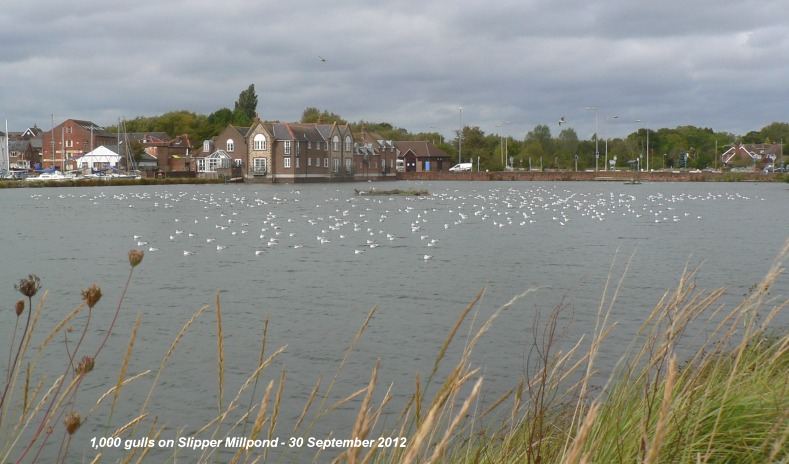
They were mostly
Black-headed Gulls with a pair of adult Herring Gulls
and 6 juveniles, plus one adult Great Black-backed
Gull. As I was watching them the whole flock rose
spectacularly into the air, some going west towards
the harbour, but most heading east towards Thorney
Island.

FRIDAY
SEPTEMBER 28 - 2012
BROOK
MEADOW
Water
Vole
Frank Naylor sent me
an excellent video he took of a Water Vole on the
river bank just south of the S-bend yesterday (Sep
27). The main part of the video shows the vole
actively feeding on the river bank followed by a short
swim down river. We have had several sightings in this
area recently, probably because it is the one of the
few spots the river can be clearly seen. Link to
Frank's video on dropbox . . .
https://www.dropbox.com/sh/144y5j76kkxyitk/8tSHlpjzf2/Water%20Vole%20Brook%20Meadow.wmv
Dragonflies
I had a walk around
the meadow this morning. I watched a large deep blue
dragonfly flying over the Lumley area. It did not
perch, so no photo. However, I think it must have been
a male Migrant Hawker. There are still plenty of male
Common Darters attracted to the sun-warmed gravel
paths.
Black
Slug
I found a fat sleek
slug with a red 'skirt' rather similar to the pale
Black Slug Arion ater that Ralph Hollins photographed
and wrote about in his wildlife diary on Sat 22 Sep .
. . http://ralph-hollins.net/Diary.htm#2209
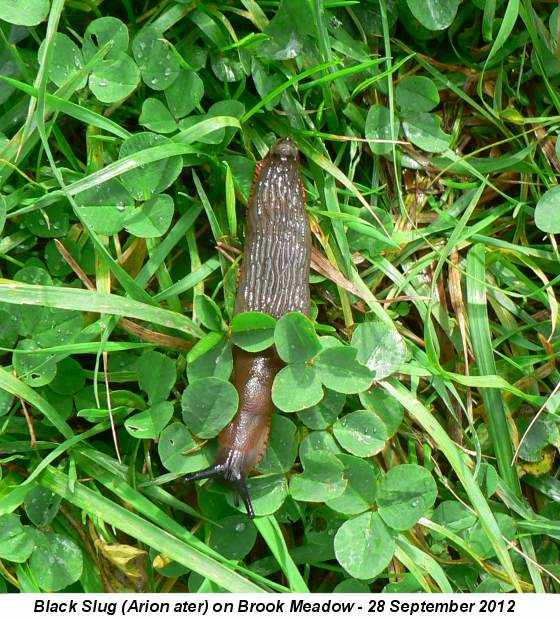
Ralph also gave a
useful link to a web site specialising in gastropods
(snails and slugs) . . . http://idtools.org/id/mollusc/factsheet.php?name=Arion%20ater%20group:%20Arion%20ater
What is clear from
this site is that the colour of slugs varies greatly.
Black Slug is certainly not always black. I include
here a useful diagram of the main parts of a slug. The
only difference between a slug and a snail is the fact
that a snail carries a shell and a slug does not.

Cuttings
pile
There is now a huge
pile of grass cuttings on the east side of the north
meadow from the annual cut. I climbed up on the pile
and found them smoking and very hot in parts. I think
it would be safe to spread out the pile to avoid any
repeat of the spontaneous combustion fire we had in a
similar pile of cuttings several years ago, which
required the fire brigade to put it out. Maybe the
contractor can be asked to make the pile lower.
Autumn
colours
I
love bronzed willow leaves at this time of the
year
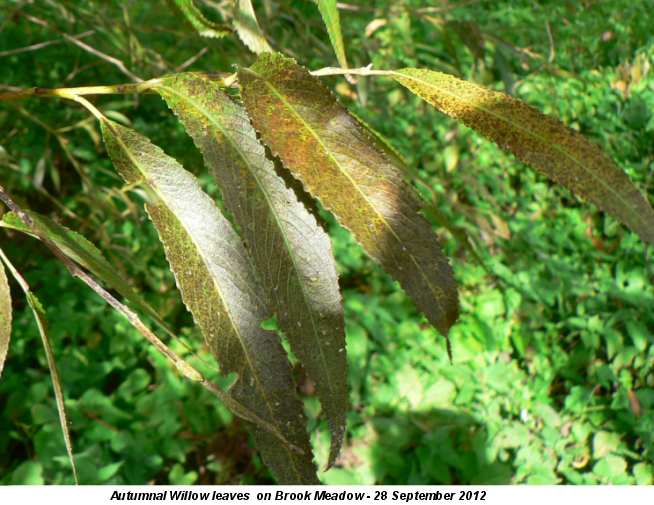
OTHER
NEWS
B.
terrestris confirmed
Bryan Pinchen
confirmed that the Bumblebee I photographed yesterday
on the Emsworth Railway Station wayside was a queen B.
terrestris.

He added "at this time
of year it could be doing one of two things, either
looking for a hibernation site, or looking to start
nesting. This species often does nest in late summer
rather than hibernate (it's partly down to the
weather) and these queens are the source of the
workers that can often be seen right through December
and into January. I have seen workers here in
Lymington almost every Dec/Jan since 1999. Nowadays
there are enough winter flowering plants in our
gardens to keep them just about going, I even saw
males in Cambridgeshire last year in early March,
suggesting a winter nest had been successful". Many
thanks, Bryan.
THURSDAY
SEPTEMBER 27 - 2012
EMSWORTH
Bumblebee
While having a look
around the Emsworth Railway Station wayside, I spotted
a Bumblebee resting on a large sheet of plastic
material. The thorax was black with an orange
'headband' across the top. The abdomen was also black
and had a orange band across it with a pale yellow
tail.

My best shot at
identification is a queen Bombus terrestris. Bryan
Pinchen says this is one of the most common Bumblebee
species, being widespread across most of England and
Wales. Still no sign of any reptiles under the felt
mats.
Garden
Ivy
The large hedge of Ivy
in my back garden had hundreds of bees and flies
feeding on the flowers along with 4 Commas and 2 Red
Admirals.
BTO
GARDEN BIRD NEWS
Woodpigeon
soars
BTO reports
Woodpigeons are visiting a record number of gardens
this year. During a typical week, 87 per cent of
British and Irish householders have reported this
species in their garden. The figures for Woodpigeons
now exceed figures for Robins (83 per cent) and Great
Tits (78 per cent). Only Blue Tits (90 per cent) and
Blackbirds (95 per cent) now stand in the way of
woodpigeons reaching the number 1 spot.
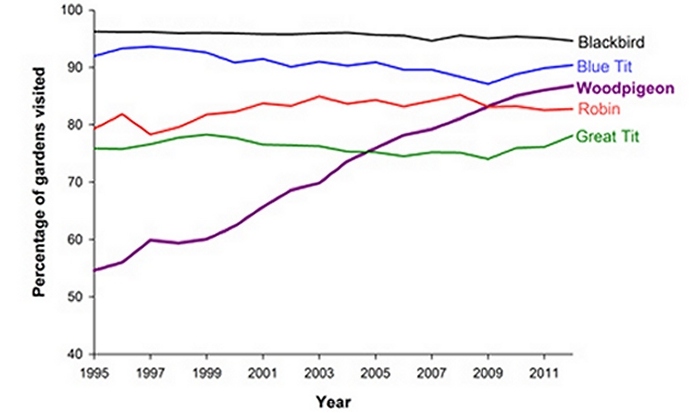
In some areas,
including Hertfordshire, Nottinghamshire,
Warwickshire, West Midlands and West Sussex, there are
strong indications that woodpigeons are already the
leading garden visitor.
My
Woodpigeon records
Woodpigeon has also
become far more frequent in my present garden
since1998. However, the big increase was between 1998
(25%) and 2007 (80%). As shown in the following chart,
since then the frequency has been fairly stable. In
2011 Woodpigeon was my number 3 garden bird in terms
of the percentage of weeks recorded (73%), exceeded
only by Goldfinch (90%) and Collared Dove (78%).

TUESDAY
SEPTEMBER 25 - 2012
EMSWORTH
Nore
Barn
10.30 - About 2 1/2
hours after high water and the tide was still well in
though the stream was starting to empty. The weather
was stormy with a gusting SW wind and frequent heavy
showers.
When I arrived a
Little Egret was feeding in the stream along with an
unringed Greenshank. Just like the old days. All we
need now is the Spotted Redshank, but that is still a
few weeks away on the basis of previous years.

I had a walk through
the woods while waiting for the tide to fall more.
Only Robin and Woodpigeon were singing.
Black-tailed
Godwits
11:00 - When I
returned to the stream, just one Black-tailed Godwit
was feeding on the edge of the saltmarshes west of the
stream. It had a red marker on the left 'ankle'
indicating a Farlington bird and small rings
indicating an older ringing. The upper ring on the
left leg was very dark, probably blue. The upper ring
on the left leg stood out clearly as yellow, but the
lower ring was dark, again probably blue.
B//R+YB - this
is my best shot at this combination. This is new one
for Emsworth. I have only one previous record of this
bird in my file which relates to a sighting by Ruth
Croger in the Avon Valley in Jan-Feb-07.
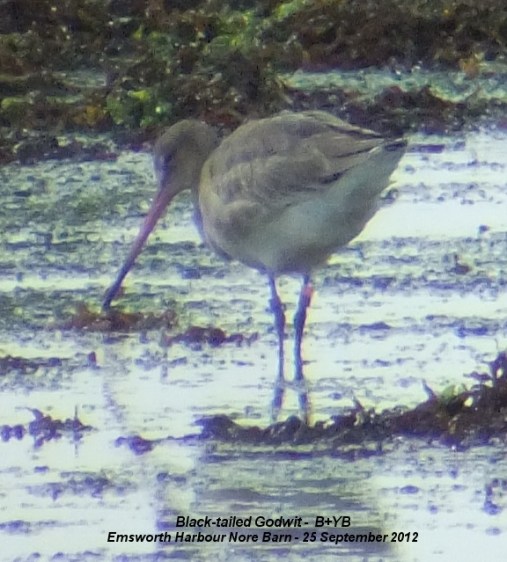
11:30 - Over the next
30 minutes a good number of Black-tailed Godwits flew
into the Nore Barn Woods creek and settled on the edge
of the far saltmarshes facing the woods. I counted a
maximum of 64 Black-tailed Godwits including another
two colour-ringed birds:
G+BG - A
regular in Emsworth Harbour for the past two winters.
Our 3rd sighting this season.
Y+WL - I was
not sure about the ring colours of this one. There was
the usual red Farlington marker ring on the left
tarsus. The left tibia ring looked orange in some
lights, but I finally decided on yellow. The upper
ring on the right leg was also not always clear. I
considered yellow as we have had YL previously seen in
Emsworth this season, but the upper right ring was
clearly white and not yellow, ie WL. This was
confirmed by my digiscoped photo. We have had only one
previous sighting of Y+WL in Emsworth Harbour which
was by Richard Somerscocks here at Nore Barn on
18-Dec-10.
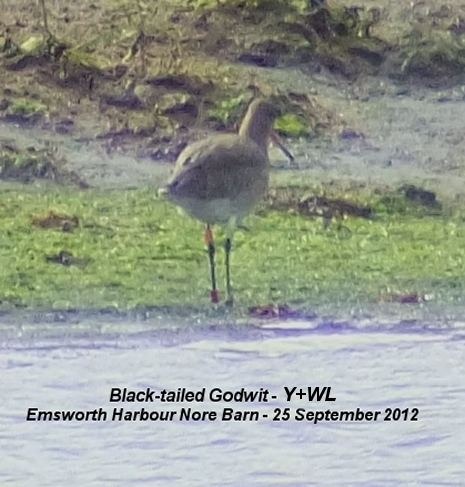
Shelduck
I counted a total of
38 Shelduck, in various stages of moult, on the
western mudflats, the first I have seen in Emsworth
Harbour this autumn. Here are two swimming up the Nore
Barn creek.
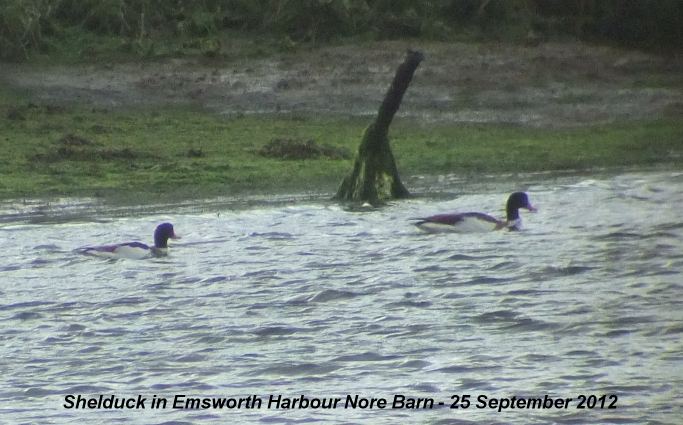
Shelduck regularly
turn up in Emsworth Harbour (west) at this time of the
year. Ralph Hollins says these early birds are not
likely to stay here but are part of a westward
movement along the south coast as Shelduck regain
their flight feathers after their annual moult off the
Dutch/German coast and move to their winter quarters,
en route picking up those adults which have stayed
here to chaperone young Shelduck hatched here and also
now able to fly. From the start of November, Shelduck
will start to settle down and through December and
January flocks will be at peak strength and there is
little movement from place to place.
MONDAY
SEPTEMBER 24 - 2012
EMSWORTH
Only had time for a
walk through Brook Meadow down to Slipper Millpond
this afternoon after the rain.
No
Bulrush flowers
Rather surprisingly,
there are no Bulrush flower spikes on the river this
year, though the leaves are growing well. It is
possible they have been cut by the Environment Agency
or taken by someone for flower arranging, though I
have not heard about this. In contrast, the Bulrush
flowers are showing normally on the Westbrook Stream
in Bridge Road car park.
Bulrush is a
rhizomatous perennial growing as an emergent in
shallow water or on exposed mud at the edge of lakes,
ponds, canals and ditches and (less frequently) by
streams and rivers. It favours nutrient-rich sites. It
spreads by wind-dispersed fruits, often colonising
newly excavated ponds and ditches and subsequently
spreading by vegetative growth. Native (change +1.01).
There is some evidence that T. latifolia increased in
frequency in the 20th century in many areas, for
reasons that are not entirely clear. Circumpolar
Southern-temperate element. (New Atlas)
Shaggy
Soldier on traffic island
I found several plants
of Shaggy Soldier on the traffic island opposite Peter
Pond all in flower. I have previously seen Shaggy
Soldier flowering on the nearby island with the boat
at the end of Queen Street. This is the only site I
know of for Shaggy Soldier in Emsworth.
Shaggy Soldier is an
annual of arable fields, waste ground, roadsides and
rubbish tips, derelict urban sites and cracks in
pavements, most often occurring in the larger
conurbations. Alien. Neophyte (change +1.07). The
species was first recorded from the wild in 1909
(Middlesex), perhaps being originally introduced with
ornamental garden plants, though it is also a
bird-seed alien. It is native of C. & S. America;
widely naturalised in Europe and elsewhere. (New
Atlas)
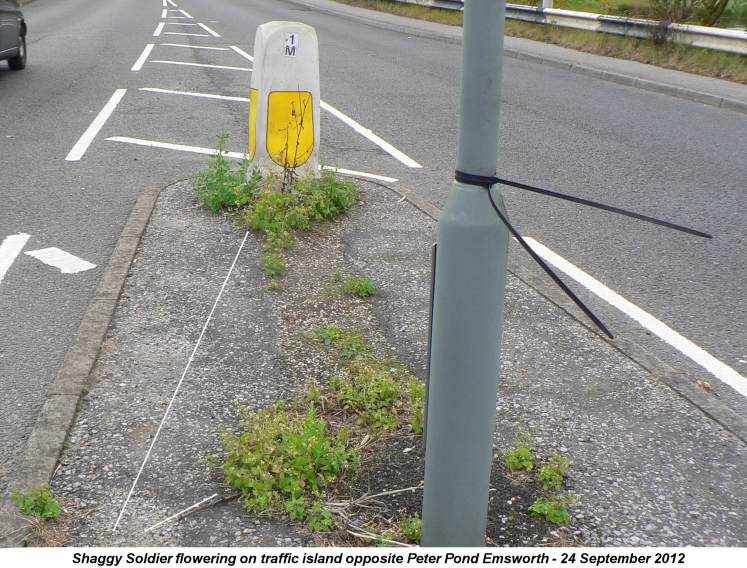
A
close-up of the Shaggy Soldier flowers

SUNDAY
SEPTEMBER 23 - 2012
EMSWORTH
Nore
Barn
Stephanie Williamson
watched hundreds of Swallows setting off from
the Warblington direction this morning heading ESE
against the wind towards Thorney. She wonders if these
are early departures. Very probably.
Stephanie also got her
a good view of a dozen Black-tailed Godwits
washing and preening by the dinghies hauled up at the
end of Warblington Rd. These are the first godwits I
have heard about at Nore Barn this season. They always
tend to turn up later there than in the main harbour
east of Emsworth. I shall have to get down there to
check them out for colour-rings.
Stephanie works for
Pesticide Action Network (PAN) UK which is a charity
concerned with Bee Declines and the Link with
Pesticides. They have a very informative web site at .
. . http://bees.pan-uk.org
The famous Spotted
Redshank should be in the Nore Barn stream (fingers
crossed) towards the end of October for its 9th winter
running. I shall be waiting with a gold medal! Here is
a reminder of what it looks like.

RALPH'S
COMMENTS
Common
Darters
Ralph Hollins
responded to my query about whether Common Darters
would be depositing eggs at this time of the year (Sep
22). He says there is no reason why Common Darter
should not be egg-laying now as the larvae will spend
a couple of years in the water before
emerging.
Garden
caterpillar
Regarding the brown
caterpillar I found in my garden yesterday Ralph
thinks it is Buff Ermine (Spilosoma luteum). It grows
to 45 mm, is common in gardens, parks, etc and feeds
on almost anything herbaceous plus trees. It pupates
in the autumn and so could be moving to pupate now. My
caterpillar is a very good match with the photo from
ukleps.org provided by Ralph.
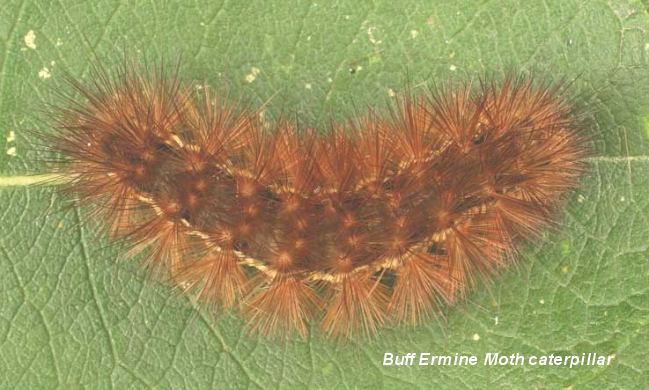
SATURDAY
SEPTEMBER 22 - 2012
BROOK
MEADOW
Chiffchaffs
I walked through the
meadow this afternoon. I heard two Chiffchaffs
calling, one from the trees north of the north bridge
and the other from Palmer's Road Copse. Chiffchaffs
are a regular summer visitor to Brook Meadow, though
we do occasionally see one in winter. I suspect we
will have had at least three on Brook Meadow this
summer, hopefully breeding successfully. Malcolm
Phillips got a photo of one on Sep 20 - see his photo
below.
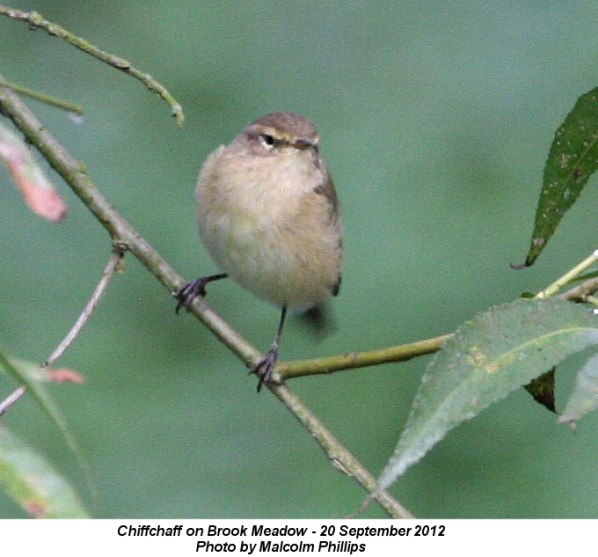
Common
Darters
I do not recall having
seen as many Common Darters as I saw on this walk.
They were mostly males with bright red bodies and were
mostly resting on the gravel path alongside the river.
They really do like to sunbathe on this warm path as
do butterflies. I did also spot a pair in tandem near
the river bank on the S-bend with the female
constantly dipping her rear onto the surface of the
water. Would she be depositing eggs at this time of
the year? Here is a photo of a male Common Darter
resting on the south bridge that I took a few years
ago.
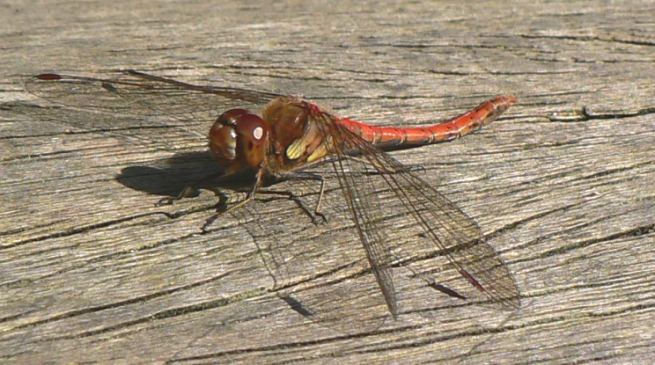
I happened to meet Jim
Berry on his way back from the Havant Wildlife Group
walk to Thorney Island. Jim said they also had lots of
sightings of Common Darters - suggesting a mass
emergence?
Southern
Hawker
While walking along
the causeway I happened to come across what I think
was a female Southern Hawker dragonfly resting on a
leaf beside the path. Here it is . . .

Comma
hutchinsoni
One of the most common
butterflies on the wing at present is the Comma. In
the midsummer emergence up to one third of the adults
are of a form called hutchinsoni which has faint
markings and is brighter and more golden with less
ragged wing edges. I think I may have seen one of
these on Brook Meadow this morning (or maybe not
looking at the photo again).
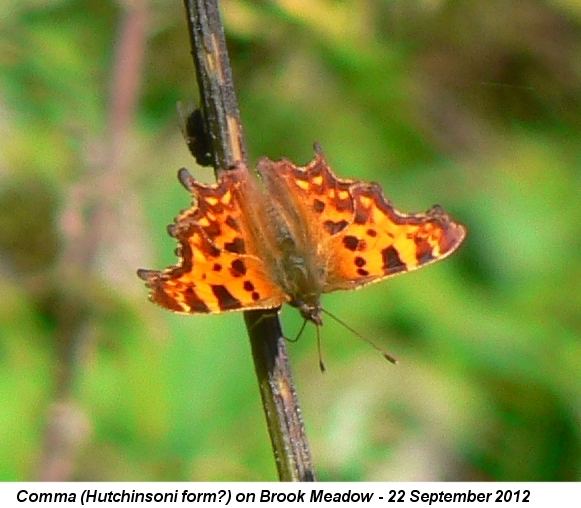
GARDEN
NEWS
We have a magnificent
hedge of Ivy along the southern wall of our back
garden which is currently in full flower. This
afternoon it was attracting an amazing number of bees
and flies as well as four Red Admirals and three
Commas. Below the hedge I happened to spot a small
caterpillar crawling along some leaves which I have
not been able to identify with any certainty. It does
not seem quite hairy enough for a woolly bear (garden
Tiger Moth).
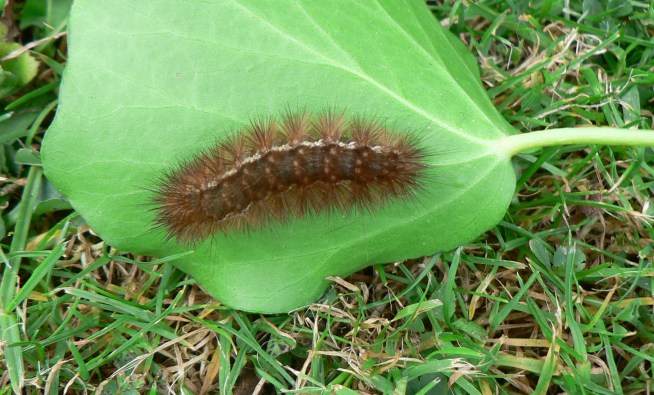
CAROLINE'S
NEWS
Tawny
Owls
Caroline French was
woken at her north Emsworth home at about 00.45 hrs
last night by the sound of two Tawny Owls calling from
the direction of Helston Drive/Woodland Avenue.
"One then seemed to
move east towards the Hollybank Recreation ground.
Both birds were making the 'keewick' call, quite
loudly and frantically. I had thought that only the
females made this call but my RSPB handbook says that
the males do too. I also heard, just once, a slightly
rough sounding 'hoooo' call, which I think was likely
to have been a female (again, according to the RSPB
handbook). The 'keewick' calls continued for a good 10
minutes. Apart from the fact that they woke me up, I
was very pleased to hear the birds as the only other
place I have heard a Tawny Owl locally is Westbourne,
although I'm sure there must be a few in Hollybank
Woods."
Hornet
"I now have two quite
large hedgehogs living in two purpose-built boxes in
the garden and I have also had a hornet visiting the
garden regularly. On one occasion I saw it fly off
with a honey bee for its larvae but mostly it was
feeding on ripe fruit in the garden
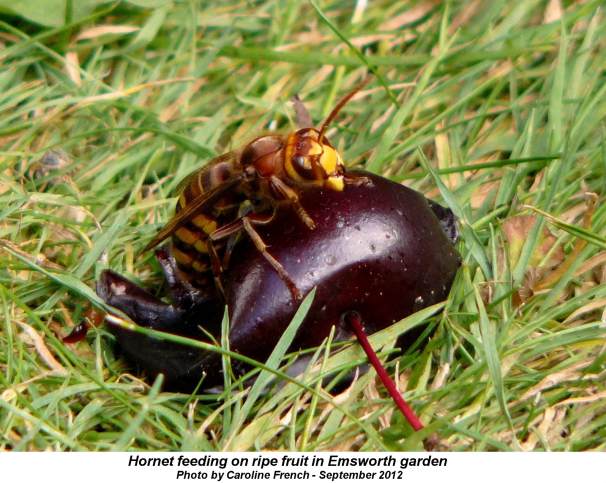
Stone
Curlew
"Away from Emsworth,
Ray and I saw our first ever Stone Curlew near
Minsmere last week. A strange-looking but lovely
bird.
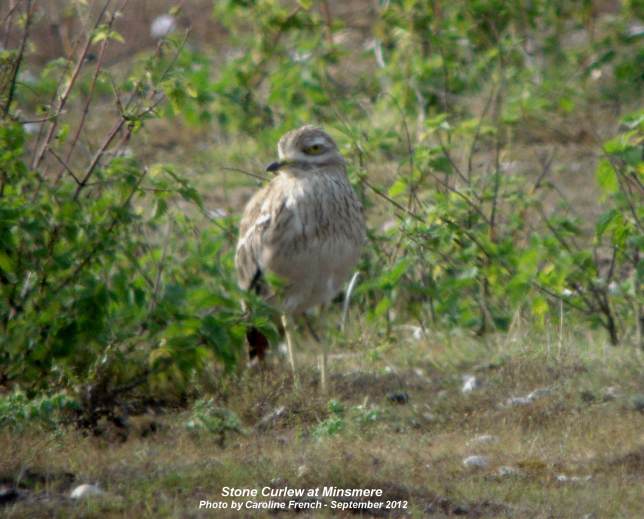
HAVANT
WILDLIFE GROUP WALK
Heather Mills reported
on this morning's walk b y the Havant Wildlife Group
On behalf of Fay who
led this mornings walk from Bridge Road, here is a
quick account. On a glorious but slightly chilly
morning, 16 attended and were met by Brian, who gave
his greetings and apologised for not joining us. We
had a very pleasant amble around Emsworth, first
noting the wonderful display of Mistletoe on the local
apple tree.
Tide out as we looked
for waders. Curlew, Oystercatchers and Black tailed
Godwits seen with 3 Pied wags on the foreshore. As we
went around the millpond, which incidentally was being
drained in preparation for tomorrow's onslaught of
rain, we saw a few more waders but nothing like
Brian's mention of over 100+ Black-tailed Godwits. As
we looked about, a male swan frightened the group by
flying right towards us and then more or less gave up
and landed at our feet against the sea wall. It
unfortunately looked a little worse for wear as it
limped off.
As we approached the
end of the pond more Black-tailed Godwits could be
seen but no rings visible. Approximate 30+. A Sandwich
tern could be seen preening. Single Greenshank seen
and Redshank amongst Turnstones and the usual
Blackheaded gulls. Further out towards Thorney, Grey
plover were some of the 39+ species seen.
We continued our walk
and had a break in front of the stilt houses and
finished by searching for Bearded Tits, to no avail.
Plants mostly bristly Ox tongue,& Mallow.
On Slipper Millpond we
noted the sorry demise of the Strawberry tree. Many
Red Admirals seen and a few large whites. An Great
Black-backed Gull looked out at us from the raft on
the mill pond but looked like a mature bird. Was this
one that bred and was back to stake an early claim to
this spot? Huge mullet seen in the marina
moat.
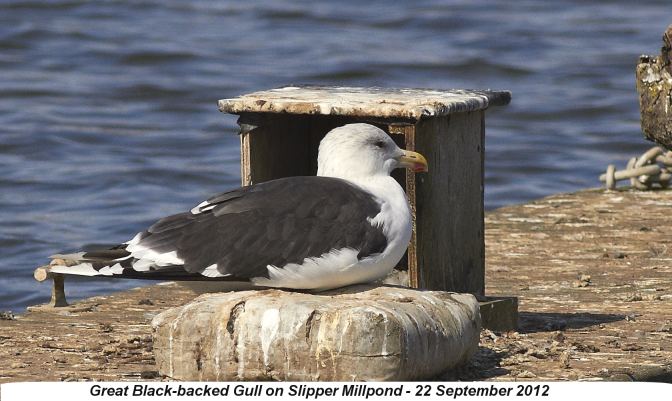
Notes
on the Great Black-backed Gull
from
Brian
Yes, this is an adult
Great Black-backed Gull, probably one of the pair that
nested on Slipper Millpond. The family with the two
youngsters are still in the Emsworth Harbour area and
are fairly regular visitors to Slipper Millpond. It
must feel like home!
from Ralph Hollins
Seeing Heather's photo
of the Adult Great Black-backed Gull back on the
Slipper Mill Raft, and noting the dark streaks it has
acquired on its head as it moves into winter plumage,
I went to see if I could find a recent photo of an
adult on Brian's web pages but failed to do so.
What I did find was a
webpage with a slide set of six pictures showing the
plumages from juvenile to adult which you might find
useful in following the development of the Emsworth
GBB dynasty and from this website I learnt something
that I did not previously know - that the
Great Black-back is
the largest gull in the world (checking this I found
that the maximum body length of a GBB is 6 cm longer
than that of a Glaucous Gull and the GBB maximum
wingspan is 8 cm longer than a Glaucous). The website
concerned is . . . http://www.allaboutbirds.org/guide/great_black-backed_gull/id
FRIDAY
SEPTEMBER 21 - 2012
BROADMARSH
11:30 - tide rising to
high water in about 4 hours.
I had to take some
garden rubbish down to the amenity tip this morning,
so I took the opportunity to have a look at the
Broadmarsh shore. I met Margaret and Martin Baggs down
there looking at the birds in the harbour. No a great
deal to see apart from a group of Herring Gull
families with juveniles, plus a few Oystercatchers,
Redshank, Curlew, Turnstone and Black-tailed Godwits.
Black-tailed
Godwit G+LG
I spotted one
colour-ringed godwit which I think was G+LG though the
light was not good and it was a good way out. The
green rings could have been blue. However, I am
reassured by the fact that G+LG was seen here at
Broadmarsh by Peter Milinets-Raby on 03-Mar-12. I have
had two previous sightings of this bird one of which
was at Nore Barn Emsworth on 19-Nov-10.
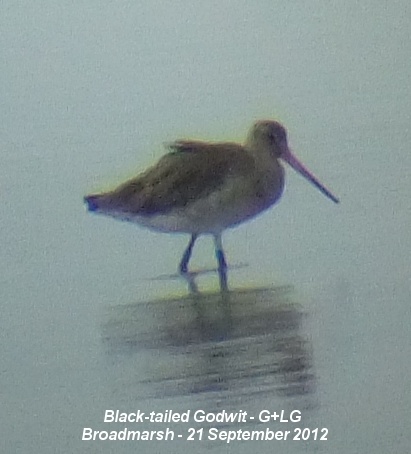
NUTBOURNE
12:15 - About 3 hours
to high water. Walked to the shore from the end of
Farm Lane. There was not much along the shore,
certainly no Black-tailed Godwits. The best birds were
a flotilla of 6 Great Crested Grebes in the bay. No
sign of any ducks.
BROOK
MEADOW
Water
Voles
Malcolm Phillips saw
another 4 Water Voles on Brook Meadow this afternoon
between 4pm to 5pm. That takes the total number of
sightings for this year to an astonishing 192.
One of Malcolm's voles
was half way between the sluice gate and the S bend,
swimming down river. Two more Water Voles were close
together near the S bend, happily feeding on the west
bank. The 4th Water Vole was seen swimming north of
the north bridge. Malcolm got some good photos from
the bridge as the vole swam towards him. Here is one
of them.
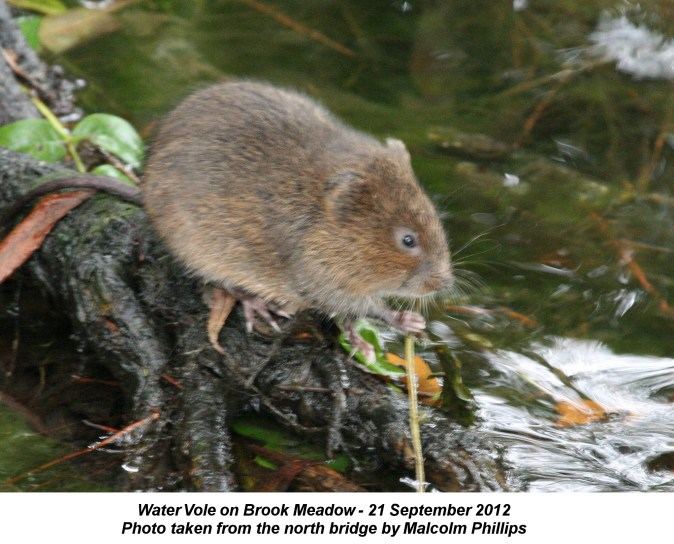
More of Malcolm's
photos are on the Brook Meadow web site at . . .
http://www.brook-meadow.hampshire.org.uk/bm-water-voles-2012.html
THURSDAY
SEPTEMBER 20 - 2012
EMSWORTH
HARBOUR
11:00 - 12:00 Tide
rising to high water in about 4 hours.
Black-tailed
Godwits
I started on the
marina seawall where around 80 Black-tailed Godwits
were feeding on the mudflats and in the channel though
there could have been more hidden amongst the boats.
As the tide came in the godwits move across to the
west bank of the channel where they are best seen from
the millpond seawall. From there I counted 128
Black-tailed Godwits which is approaching the number I
recorded yesterday.
I found three
colour-ringed Black-tailed Godwits, G+WR,
G+BG and the mystery B+BL which I also
saw yesterday. See noteabout this bird below. I
spotted one colour-ringed Greenshank - NY+GR.
There are not nearly so many Redshank in the harbour
as in previous years. Only about 20 or so were there
this morning.
Mystery
Godwit - B+BL
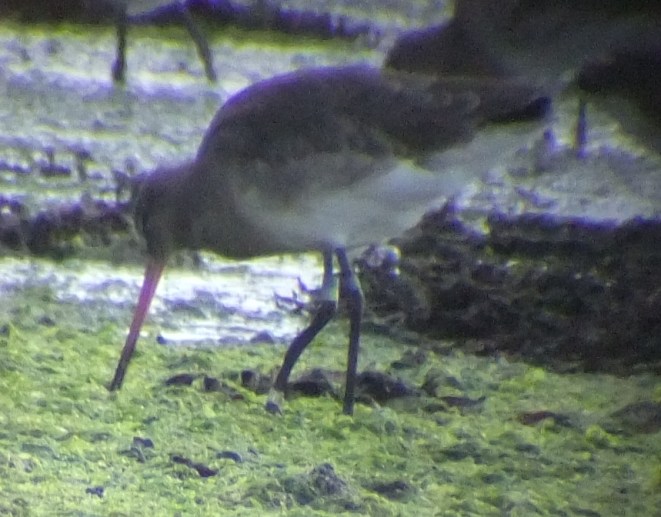
Anne de Potier replied
to last night's news about the mystery colour-ringed
Black-tailed Godwit that I saw in Emsworth Harbour
yesterday - B+BL. Apparently there are two different
birds, one has a red ring on its left leg - ie
B//R+BL, while the other one (our mystery) that I saw
yesterday does not have a red ring, but has a metal
ring on its right leg - ie B+BL//metal. Anne's
sighting on 19 September last year was of B//R+BL.
which she also saw several times last year over at
Fareham.
SLIPPER
MILLPOND
No sign of the Great
Black-backed Gulls today, but a
Lesser
Black-backed Gull
was on the south raft. The first signs of the autumn
gathering of Coot with 10 in the Slipper Mill basin
below the sluice.
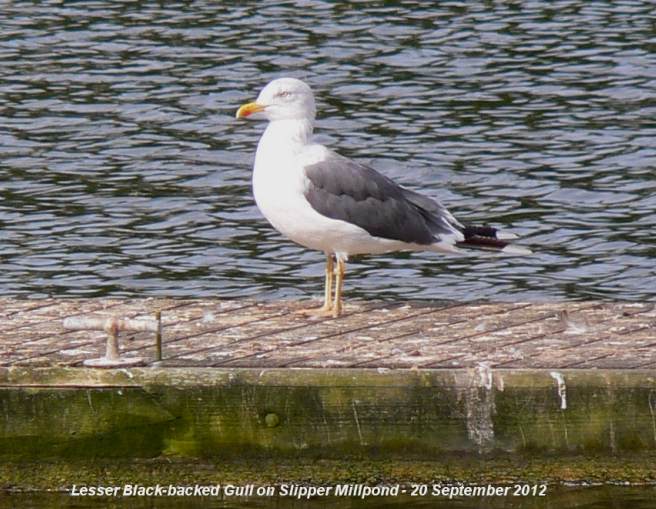
BROOK
MEADOW
The annual cut carried
out by the regular contractors is carrying on. Part of
the centre meadow has been cut and cleared and part of
the north meadow is cut and partially cleared. The
cuttings have been piled high on the usual tipping
area. No signs of any smoke at the moment!
Water
Voles
This afternoon at
about 4.15 I met Malcolm Phillips on the south bridge.
As we were standing there we noticed the vegetation
moving on the east bank of the river, a sure sign of
Water Vole activity. As we watched it became clear
that there were two voles active on the east bank
about 20 and 40 metres north of the bridge. The Water
Vole closest to us was eating the Water Mint plants
which can be seen flowering in the photo. It almost
seems to be smelling their strong minty aroma.
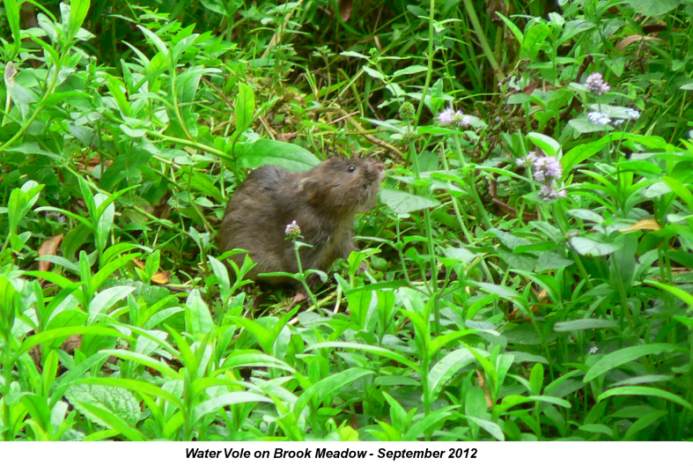
Malcolm told me he saw
a Water Vole in the same area at about 11am this
morning. It was on the east bank and swam across the
river to the west bank. Malcolm got a photo of it
swimming.
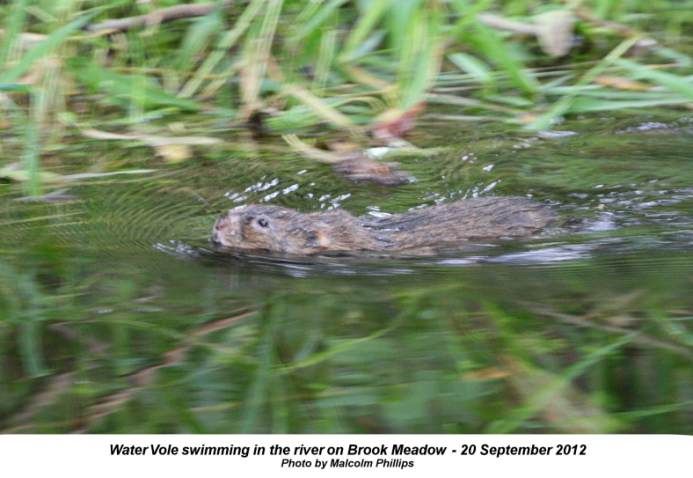
Birds
Malcolm Phillips also
saw a Goldcrest in the north-east corner of Brook
Meadow yesterday and a Chiffchaff in Palmer's
Road Copse this morning.

Spider
While we were on the
bridge, Malcolm and I happened to disturb a lovely
4-Spot Spider (Araneus quadratus) with round yellow
abdomen. It scuttled off beneath the bridge, no doubt
to construct another web.
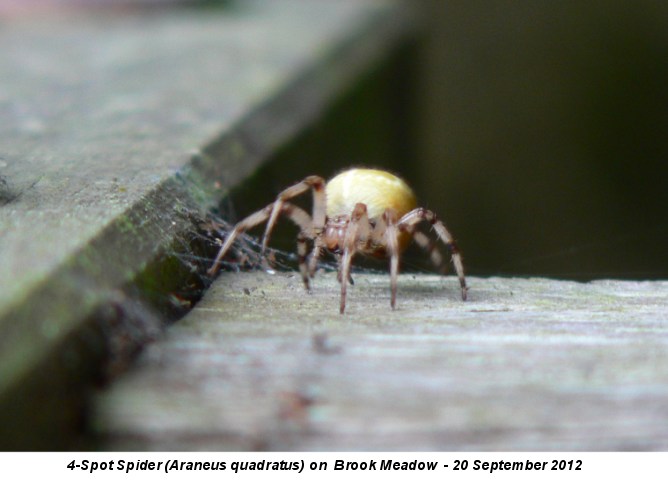
OTHER
NEWS
Comma
butterfly
A very bright Comma
butterfly settled briefly on the rough cobbles of the
Emsworth Railway Station wayside. Possibly a
hutchinsoni form which do occasionally occur in the
midsummer emergence.

Slow-worm
and Grass-snake
Tony Wootton captured
this amazing image of a Slow-worm and a young
Grass-snake entwined beneath an iron sheet at
Titchfield yesterday.
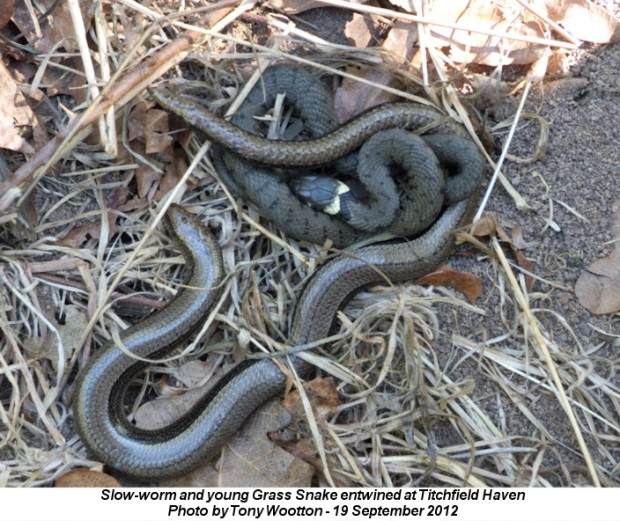
WEDNESDAY
SEPTEMBER 19 - 2012
EMSWORTH
HARBOUR
11:15 - 12:30 Tide
rising to high water in about 3 hours.
Black-tailed
Godwits
From the millpond
seawall I counted 134 Black-tailed Godwits in their
usual spot on the western bank of the main channel.
This was the best count so far this season. As the
tide came in they were gradually pushed off the
islands in the channel and onto the town shore. About
half the birds flew over towards Thorney Island. Two
of the godwits were feeding close to the millpond
seawall where I was standing. There were 6 Turnstones
feeding with the godwits.
I managed to locate
four colour-ringed birds, though there could well have
been more as the birds had their legs in water for
much of the time.
G+WR - 4th
sighting this season.
OY+LR - 3rd
sighting this season
G+BG - 1st
sighting this season. A regular in Emsworth over the
past two winters.
B+BL ? - I am
not 100% sure about this bird's ring combination as
the rings were thin and grey. I am sure there was no
red marker ring on the left tarsus, but there was a
metal ring on the right tarsus.
I have a record of two
sightings of what could have been the same bird at
Fishbourne from Anne de Potier on 03-Sep-08 and
19-Sep-11. Anne commented on the first of these
sightings . . . "B//+BL//metal, all small rings.
Honestly there was nothing on the left tarsus that I
could see, and I was close. Definitely not a tall red.
And the L was not W." Nick Humphrys wondered at the
time if it was B//R+BL which had lost its red ring.
Here are two
digiscoped photos of the bird, one showing the metal
ring on the right tarsus and the other showing nothing
on the left tarsus.

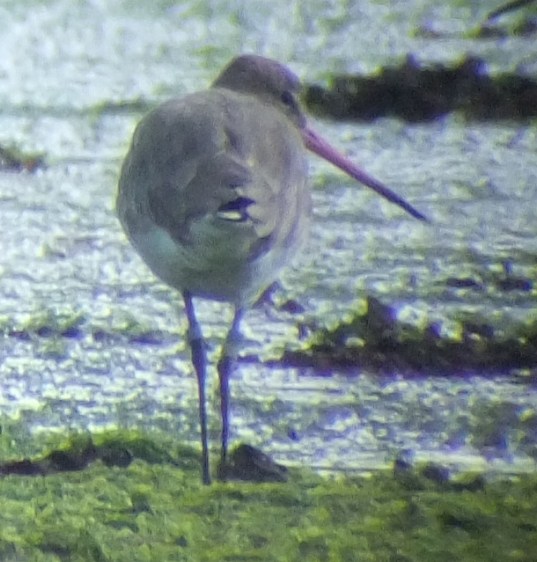
For more Godwit news
go to . . . Black-tailed
Godwits
Great
Black-backed Gulls
Passing Slipper
Millpond on my way to the marina I noticed two adult
Great Black-backed Gulls on the pond, one on the
centre raft and the other on the south raft. They were
probably the ones that nested here this spring. I also
saw what I assume were the two juveniles in Emsworth
Harbour. I am surprised that they are staying around
so long after fledging.
SUNDAY
SEPTEMBER 16 - 2012
BROOK
MEADOW
Water
Vole
I spotted a Water Vole
as it emerged briefly from beneath the overhanging ivy
vegetation on the west bank of the river about 20
metres north of the north bridge. It immediately went
back under the bank and I did not see it again. This
was sighting number 184 for the year so far.
Plants
Michaelmas Daisies are
just starting to flower on the east side of the Lumley
area by the Lumley Stream. They are always much later
opening than those on the south bank of Peter Pond.
There is plenty of fresh growth of what looks like
Annual Meadow-grass. There are a few new flower spikes
of Marsh Woundwort at the north end of the Bramble
path.
Birds
The autumn song of the
Robin was the only bird song I heard. A Great Tit was
heard calling, but not singing. I watched a tiny Wren
feeding actively in the Branched Bur-reed stems on the
river bank in front of the observation fence.
Insects
and spiders
Red Admiral and a
couple of whites were the only butterflies I saw.
Spiders were on webs everywhere, but all were Garden
Spiders.
SLIPPER
MILLPOND
The two juvenile Great
Black-backed Gulls were back on the pond, one on the
north raft and the other on the water. Five Cormorants
and an adult Herring Gull were on the centre raft. I
watched one of the Cormorants struggling to swallow a
huge Eel over a period of several minutes while
skirmishing with two other Cormorants out to steal the
prize.
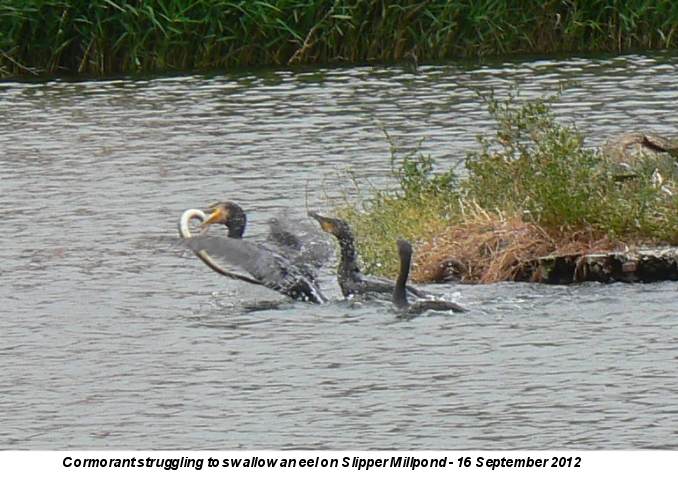
FRIDAY
SEPTEMBER 14 - 2012
Kew
Gardens
Jean and I visited Kew
Gardens today. A fascinating place with some great
trees and thousands of exotic plants. But the
experience was largely ruined by the constant roar of
overhead jets taking off from Heathrow every 4 minutes
or so. I felt really sorry for a walks guide who was
forced to stop several times due to the deafening
noise. A 4th runway will make this worse.
Despite the noise, we
admired some magnificent oaks, including a fine Red
Oak - a North American 'black oak' with red leaves
in autumn and very small acorns.
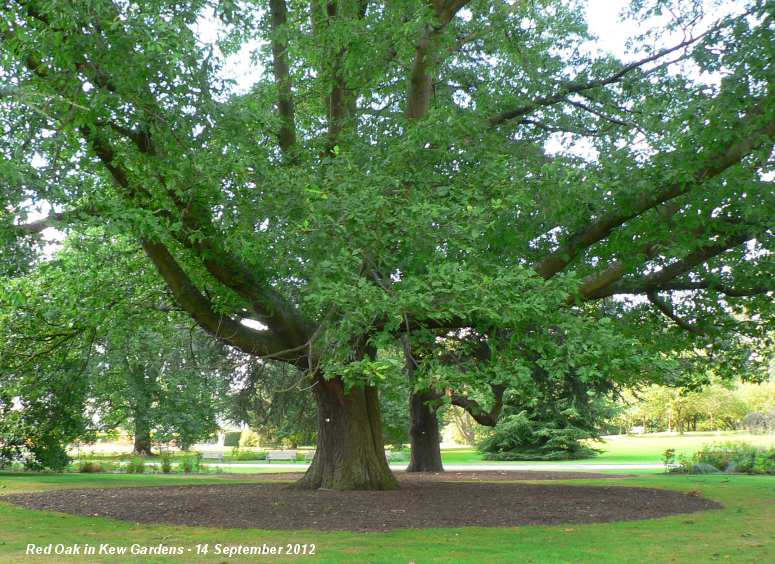
I also noted an
unusual 'One-leaved Ash' with one big undivided leaf
in place of the leaflets of the normal Ash.
THURSDAY
SEPTEMBER 13 - 2012
Stansted
East Park
Jean and I had a walk
through the east park this morning. The wild flower
meadow on the west side of the public footpath running
in front of the house had masses of Wild Carrot in
various stages of flowering and seeding. We also
noticed Burnet-saxifrage in flower - another
white umbellifer, but having no bracts and slightly
ridged stems. Also, in flower near the path were
Cat's-ear, Agrimony, Creeping Thistle, Prickly
Sow-thistle, Scentless Mayweed, Fat Hen, Common
Ragwort, Autumn Hawkbit. Common Knapweed, Field
Bindweed, Ladies Bedstraw, Common Fleabane, Selfheal
and Red Clover.
Walking up the track
past the Iron Gate Cottages we had an excellent view
of a Yellowhammer perched on overhead cables.
We did not go all the way along the track as chemical
spraying was taking place in the fields with the wind
taking the spray across the path, so we turned back.
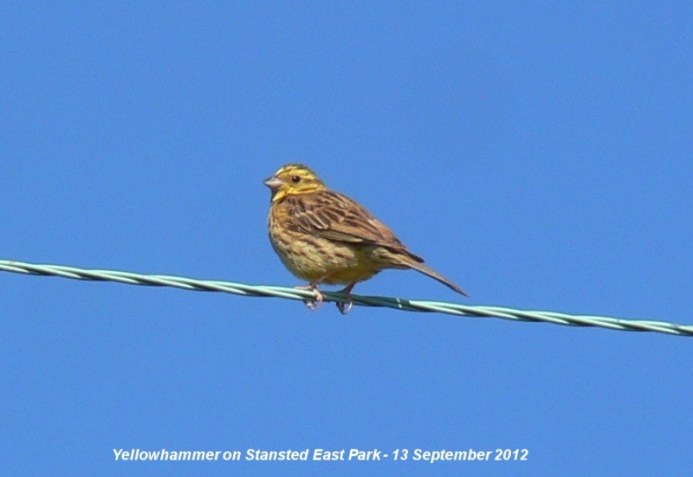
Slipper
Millpond
Adult Great
Black-backed Gull was on the south raft.
Brook
Meadow
Maurice Lillie was
lucky enough to see two Long-tailed Tits
grooming themselves this morning. They were so intent
on tarting themselves up that he got the impression
they hadn't seen him. As he says, they are normally so
shy. Here is one of Maurice's very nice images.

WEDNESDAY
SEPTEMBER 12 - 2012
EMSWORTH
NEWS
Chiffchaffs
on Brook Meadow
Maurice Lillie spotted
some small birds with distinctive white underbellies
feeding in amongst willow shoots on Brook Meadow. I
can detect the hint of a supercilium on the photo
which suggests Chiffchaff, possibly youngsters. This
is good news as it indicates that they have bred
successfully on Brook Meadow.
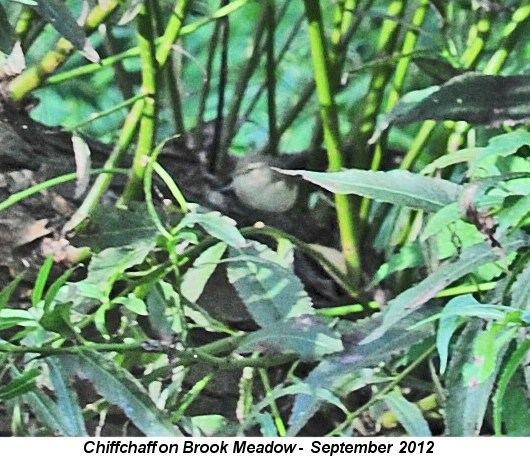
Wildlife
in River Ems
Malcolm Phillips went
round the meadow for an hour this afternoon during
which he saw and photographed an Eel and a Trout in
the river by the south bridge. Here is the Eel.
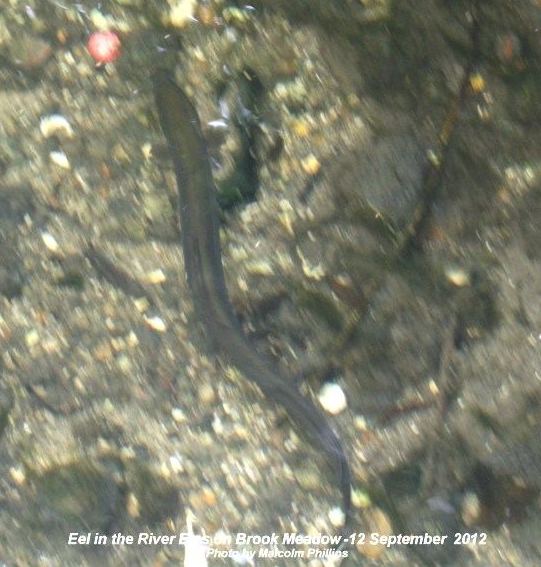
Malcolm also snapped a
juvenile Moorhen. There are usually up to three pairs
on the river, so it is good to know they have bred
again this year.
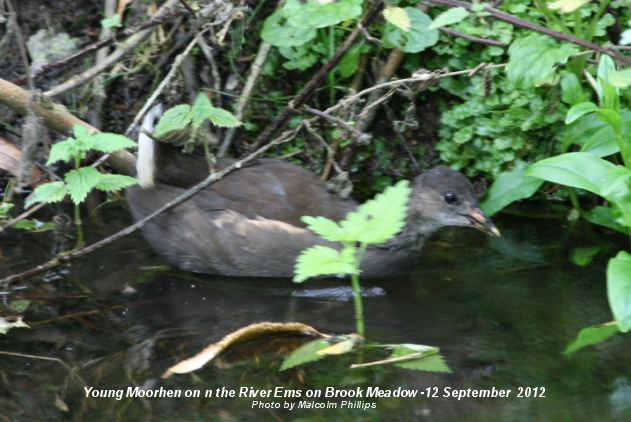
Great
Tit song
While walking to the
shops this morning I heard the ringing tones of a
Great Tit in full song for the first time this autumn.
Great Tits do typically sing in September and October
after a long period of silence, but will be quiet
again until the New Year.
Emsworth
Harbour
I had a quick look at
the eastern harbour at low water from the millpond
seawall this afternoon. I counted 78 Black-tailed
Godwits, though there could have been more hidden
behind the boats. I saw one colour-ringed bird - the
regular G+WR. Also, in the harbour were 4 Turnstone,
plus Redshank, Greenshank, Oystercatcher and Curlew.
LANGSTONE
HARBOUR NEWS
Chris Cockburn sends
the latest news up date about the breeding seabirds.
Little terns - 40
nested but no young were fledged.
Common terns - 92
pairs nested in the harbour. 23 youngsters fledged all
on the Oysterbeds
Sandwich terns - 46
pairs nested in the harbour, 45 on South Binness
Island and 1 at the Oysterbeds. No young were
fledged
Black-headed gulls -
3643 pairs nested on the harbour islands and fledged
only 12 young
Lesser black-backed
gull - One pair nested on S Binness but failed to
fledge young
Mediterranean gulls -
58 pairs fledged 2 young on S Binness
Finally, please do
remember that our gulls and terns are relatively
long-lived so they can cope with the occasional
disastrous breeding season, but they would be in
trouble with too many consecutive ones.
SUNDAY
SEPTEMBER 9 - 2012
BROOK
MEADOW
Water
Voles
Malcolm Phillips went
round the meadow late this morning and for the first
time in 3 months he saw 2 Water Voles, one by the
south bridge and the other by the sluice gate. Malcolm
managed to take a few photos. Here is one peeping from
behind some leaves on the river bank.
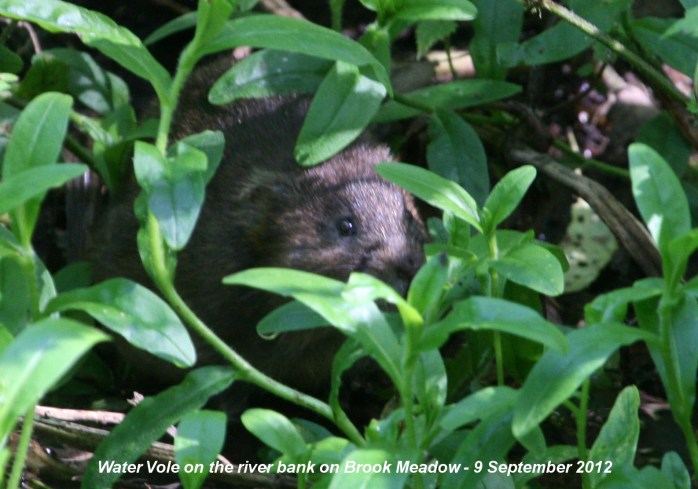
These take the total
number of sightings for the year to 182, which far
exceeds that of any other year since 2005. See the
Water Vole web page for full details . . .
http://www.brook-meadow.hampshire.org.uk/bm-water-voles-2012.html
Spiders
Spiders are everywhere
on their webs, usually stretched out between plants so
that it is hard to avoid them when walking through
vegetation. Most are the common Garden Spider (Araneus
diadematus). However, I did see a 4-spot Spider
(Araneus quadratus) a web on the Seagull Lane patch.
It had a very yellow abdomen but had the four
distinctive spots from which it gets its name.
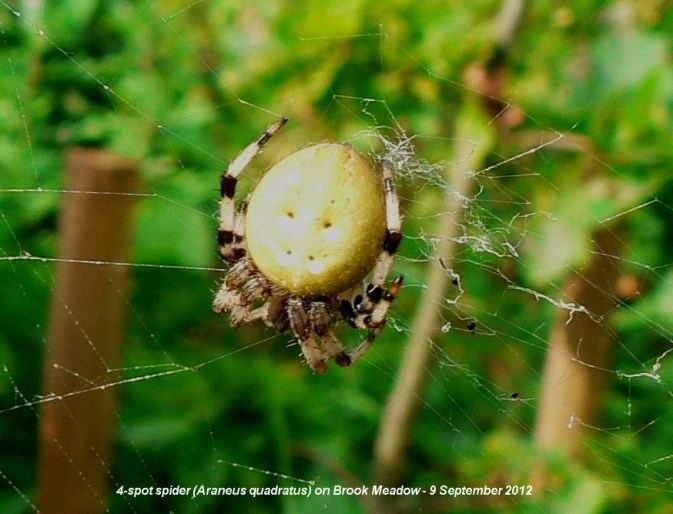
Autumn
colours
The meadow is
currently a kaleidescope of brown, yellow, white and
green. The brown Hogweed flowerheads contrast well
with the white curled seeds of Great Willowherb.

The yellow flowers of
Hoary Ragwort still dominate the centre of the north
meadow and those of Common Fleabane the Lumley area.
The fruits are forming on the Strawberry Clover on the
east side of the Lumley area, but not yet strawberry
coloured. I spotted yet another Amphibious Bistort in
flower in the same area. There is a good crop of
fruits (conkers) on the Horse Chestnut tree behind the
signcase at the Lumley gate. The huge Butterbur leaves
are curling and browning.
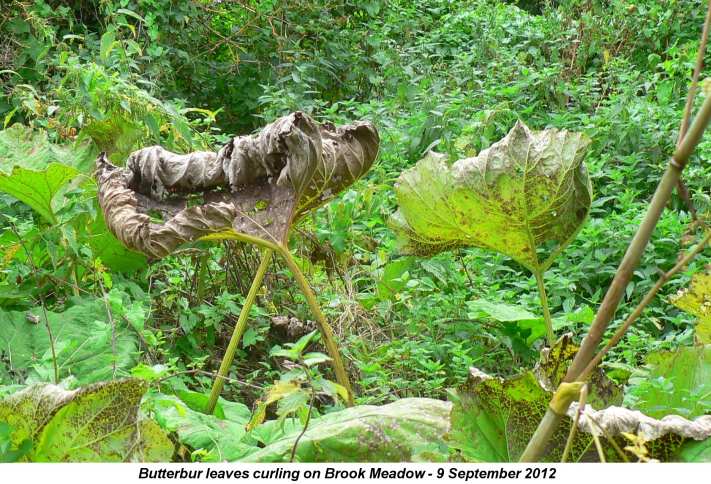
Birds
The only bird song to
be heard on the meadow at present is the wistful
autumn song of the Robin, so different from its bright
and cheery spring song. Other than that there are the
sweet call of the Chiffchaff, the sharp ringing call
of the Great Tit and the creaky whistle of the
Dunnock.
EGRET
ROOST
Little Egret numbers
are now starting to build up in their traditional
autumn roosts. Just after sunset on Sep 6, Ralph
Hollins counted 106 in the trees behind Langstone
millpond with still enough light for others to
arrive.
FRIDAY
SEPTEMBER 7 - 2012
FISHBOURNE
CHANNEL
Black-tailed
Godwits
I checked the
Fishbourne Channel from the Apuldram shore this
morning on a rising tide. The weather was perfect with
warm sunshine and just a light wind. I enjoyed a cup
of coffee and a Heidi's jam doughnut on the
saltmarshes before I started serious birdwatching.

The Godwits were
mostly snoozing on the edge of the channel, but some
were feeding on the open mudflats. A few were on the
far side of the channel. I counted a total of 104
including one colour-ringed bird. There may well have
been more colour-ringed birds, but I could not see
their leg. Today's bird was O+YL which has been
regular in the Fishbourne and Bosham channels since
2006. This is not a good picture, digiscoped at a
distance and in a heat haze, but better than nothing!
In fact, my last sighting of this bird was earlier
this season on 17-Jul-12 in Emsworth Harbour.
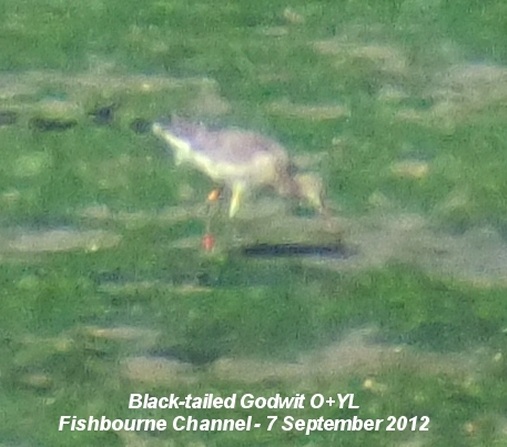
Other
waders
There were also good
numbers of Oystercatcher, Redshank and Curlew in the
channel along with a few Greenshank.
LANGSTONE
HARBOUR
Malcolm Phillips went
to the entrance to Langstone Harbour today and was
surprised when this Harbour Seal popped up in
front of him. Seals are actually quite common in the
harbour, but one has to be lucky to see one like this.
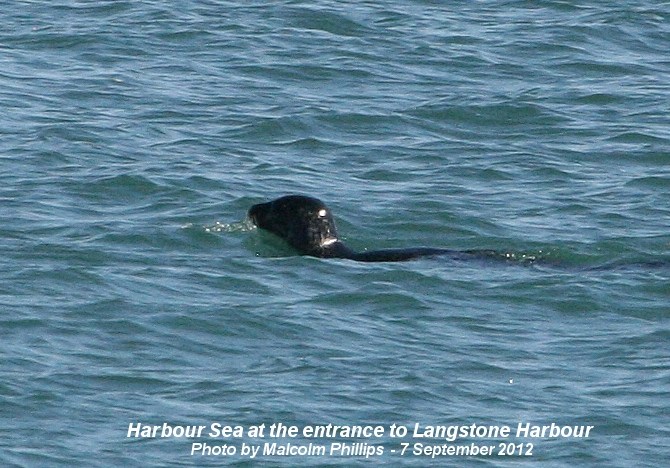
Malcolm also captured
this very fine image of a Sandwich Tern flying
into the harbour.
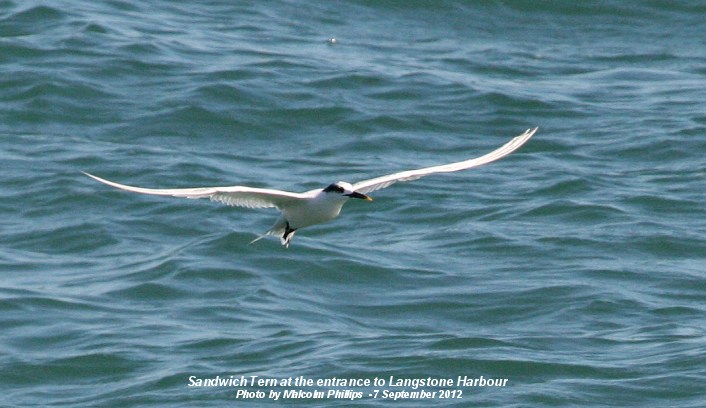
SMALL
TORTOISESHELL
Following on from the
very rare form of Small Tortoiseshell (Lutea) seen in
Southbourne that I reported yesterday. Brian Lawrence
sent me the following fine image of a standard form of
Small Tortoiseshell that he took in Hollybank Woods on
Aug 22 this year. It is good to hear they are still
about as Small Tortoiseshells have been having a
distinctly rough time over the past few years.
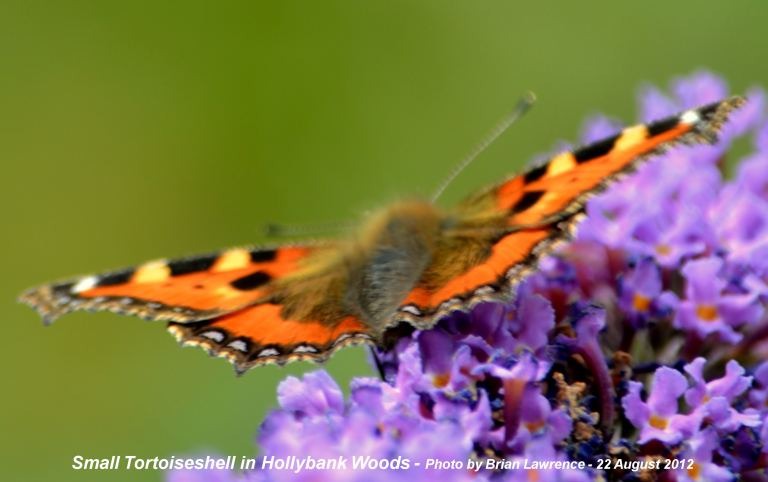
THURSDAY
SEPTEMBER 6 - 2012
EMSWORTH
HARBOUR
Black-tailed
Godwits
I watched the tide
rise in the harbour this morning from the millpond
seawall from 11:30 to 13:30. The rising water
gradually pushed the Black-tailed Godwits closer
together on the small islands of rock and mud. They
were chattering away quite loudly. A number of people
passing by stopped to ask about 'those brown birds'
and I was able to tell them a bit about them. Finally,
as happened yesterday, all the birds flew to the town
beach, which was where I did the final count of 108.
So, numbers are building up from 76 on Sept 4.
I logged three
colour-ringed birds
G+WR and
W+GO have already been seen this week.
OY+LR - I was
able to confirm this combination that I was unsure
about yesterday. OY+LR was ringed as a chick in
Iceland in July 1999. It has been regular in Emsworth
Harbour over the past 5 winters. It tends to arrive in
Sep-Oct and leave by Dec.
Other
observations
There was no sign of
the Great Black-backed Gulls today, but a Lesser
Black-backed Gull was on the mudflats with the Godwits
for some of the time, possibly the same bird that I
saw on Slipper Millpond yesterday.
WATER
VOLES
Maurice Lillie saw the
first Water Voles for some weeks on Brook Meadow at
9am this morning. There was one adult and one juvenile
swimming and moving around on the west bank about 4
metres south of the 'S' bend on the Ems. This takes
the total sightings for the year so far to 179 which
is our best ever year record sincew 2005.
See full report at . .
. http://www.brook-meadow.hampshire.org.uk/bm-water-voles-2012.html
VERY
RARE SMALL
TORTOISESHELL
(ab. lutea)
Ralph Hollins noted
the following on the Sussex Butterfly Conservation
site for Tuesday 4 September 2012 . . .
http://www.sussex-butterflies.org.uk/sightings.html
"Amazing sighting of
Small Tortoiseshell ab. lutea in Emsworth. It was a
brilliant creamy-white which the photo (above) doesn't
do it justice (taken with an elderly camera phone).
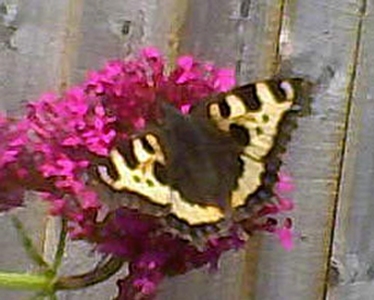
Seen on the Sussex
side of the Hants/Sussex border. The butterfly ground
colour was a uniform buff-white with otherwise normal
markings. Any others seen? It was a spectacular event
for Southbourne! (Ann and Alan Wingrove)
The photograph has
been seen by both Colin Pratt and Neil Hulme and there
is a suggestion that the butterfly in question might
be ab. pallida, the opinion of an even higher
authority (some sort of minor deity I can only
presume) is now being sought. However, whether palida
or lutea it will, apparently, be a first for Sussex."
ed.
WEDNESDAY
SEPTEMBER 5 - 2012
EMSWORTH
HARBOUR
I watched the tide
rise in the harbour this morning from 11:00 to 12:30,
About 3-4 hours before high water at 15:00.
Black-tailed
Godwits
I started on the
marina seawall where I could see the Godwits on the
mudflats. Since most of them were on the regular
roosting spot on the west bank of the main channel, I
decided to head over to the millpond seawall to get a
better look at them as the tide pushed in. From the
millpond I could see 72 godwits on the near side of
the channel and another 22 were feeding on the eastern
shore making a grand total of 94 - the most so far
this season.
I think I spotted a
juvenile Black-tailed Godwit with a pale
cinnamon wash over its neck and breast and neat warm
buff fringes to the small brownish upperpart feathers.
Pete Potts confirmed that it was a juvenile
Black-tailed Godwit.
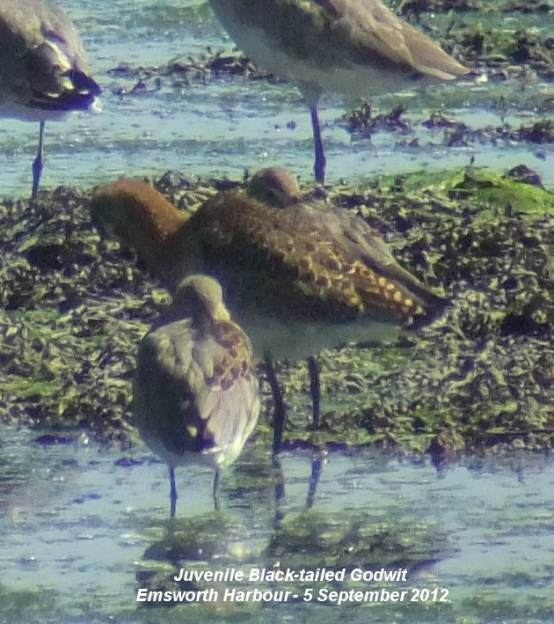
I watched the godwits
for about an hour as the water gradually rose and
pushed them onto smaller and smaller islands of rock
and mud. I scanned each bird for colour-rings, but
only located two. G+WR which was also here
yesterday. I could only see one colour-ringed
combination leg of the other godwit - LR. It is
possible that this was OY+LR which has been a
regular wintering bird in Emsworth Harbour where it
was recorded 11 times last autumn/winter from 25-Sep
to 22-Dec.
Great
Black-backed Gulls
At one point around
12.15 the majority of the godwits were clustered
together on a small island with an adult Great
Black-backed Gull for company. An extraordinary sight
which I have never witnessed before.
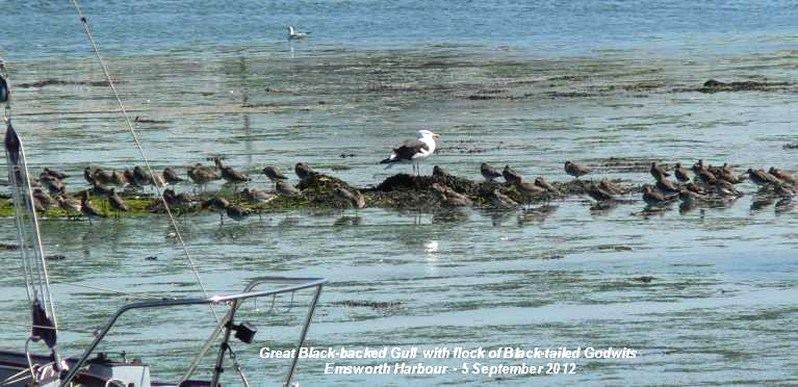
The gull was probably
one of the parents from the Slipper Millpond nest
earlier in the season. I saw the two juveniles from
the brood frequently during the morning flying between
the harbour and the millpond. Finally, as the last
remaining island disappeared, the godwits flew onto
the east beach in front of the town.
Other
observations
An adult Lesser
Black-backed Gull was standing on the south raft on
Slipper Millpond.
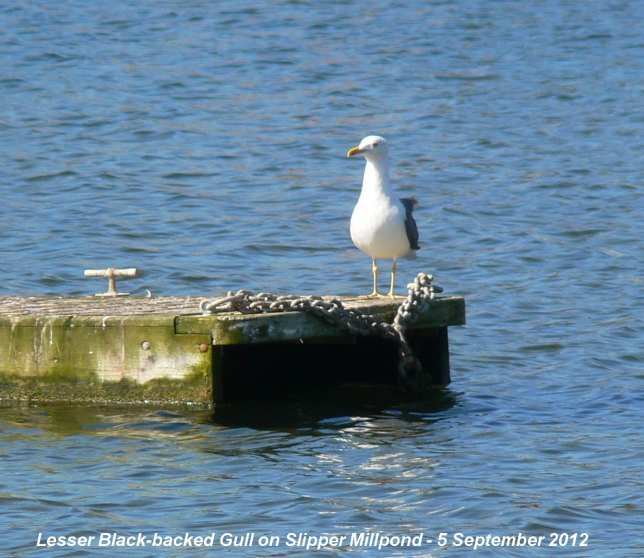
INTERBRIDGES
SITE
This afternoon I met
up with Gareth, an ecologist working for Aluco
Ecology, on the Interbridges Site on the east side of
New Brighton Road. Aluco Ecology have been employed by
the owners of this land to undertake ecology related
works on the site to fulfil a planning condition. The
site was in fact granted planning permission in year
2004, but little has happened since then. However,
this permission was renewed this year and development
could take place fairly rapidly.
As part of the survey
works Aluco Ecology are undertaking on site they are
looking to agree a biodiversity compensation package
with Havant Council to fund local wildlife
conservation projects. Gareth thought the line of Lime
trees on the south side of the site might be spared in
the development, but everything else would go. The
area would involve a yard with industrial units.
Gareth had previously
surveyed the site and located some extra plants not
logged in 2004. Notably Corky-fruited Water-dropwort,
Bee Orchid, Hairy Sedge and Spiked Sedge.
Emsworth
Railway Station wayside
At my invitation,
Gareth had a look at the new Emsworth Railway Station
wayside which is directly opposite the proposed
development area on the west side of the New Brighton
Road. He thought it was a very interesting area from a
wildlife point of view and fully approved of our plans
to preserve it as a natural habitat. However, he
stressed the need for scrub management which he
thought could be funded from the compensation from the
Interbridges Site development. He would get in touch
with Terry Green of Southern Railway to discuss this
arrangment.
Narrow-leaved
Water-plantain
Our most exciting find
on the railway site was a flowering plant of the rare
Narrow-leaved Water-plantain in the concrete lined
channel that comes under the A27 to the west of the
main site. I think this is a feeder stream for the
Westbrook Stream where we have a number of well
established Narrow-leaved Water-plantain plants.
Gareth also noted what appeared to be Remote Sedge
growing in the same channel.
Prickly
Lettuce
Gareth pointed out two
forms of Prickly Lettuce that were growing close
together on the northern track, one with whole
lanceolate leaves and the other with lobed leaves. He
thought the lobed form used to be more common, but the
other form had now taken over. I had never noticed the
differently shaped leaves before. Interestingly,
Wikipedia gives a reference to an American paper on
'Lobed Prickly Lettuce' where some leaves are lobed
others not so. Maybe American Prickly Lettuce is more
lobed than the British version? See . . .
http://www.naturemanitoba.ca/botany/wildPlants/LobedPricklyLettuce.pdf
Gareth also noted what
he thought was Small-flowered Crane's-bill.
BROOK
MEADOW
After leaving Gareth,
I went onto Brook Meadow to look for the Clouded
Yellow that I saw, but failed to photograph, on the
Lumley area yesterday. There were several White
butterflies flitting around the Common Fleabane
flowers, but no sign of the Clouded Yellow. However, I
had a fine Southern Hawker flying near me and
when it settled I was able to take the following
photo, which I think confirms it as a female.
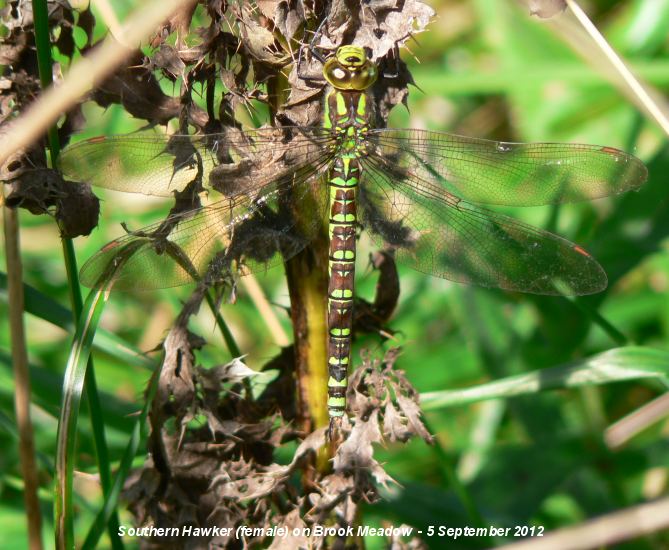
TUESDAY
SEPTEMBER 4 - 2012
EMSWORTH
HARBOUR
10:15 - 11:15 -
Viewing the harbour from the Emsworth Marina seawall.
About 3-4 hours before high water at 14:28.
Black-tailed
Godwits
I counted a maximum of
76 Godwits feeding in the low water channel. As the
tide rose they assembled along the edge of the main
channel making them easier to count. Among them were
two 'old friends' - colour-ringed birds.
W+GO - Ringed
Farlington. 20 Oct 1995 as adult male. A mega-regular
wintering bird in Emsworth Harbour since 1996. This
was our 112th sighting. It usually arrives here in
September and for the past two winters has departed in
December.
Pete Potts says good
to know W+GO is still alive. Our oldest one is c.20
years and the oldest UK record c.23 years and the
oldest Dutch limosa bird is c.30 years old so a way to
go yet to become the oldest ever islandica and even
more to become the oldest godwit of either race!
However I am sure we will smash the records given time
and continued collaboration.
There should be lots
juvs on their way to us it has been a good breeding
season and some have yellow flags on so please look
out for them.
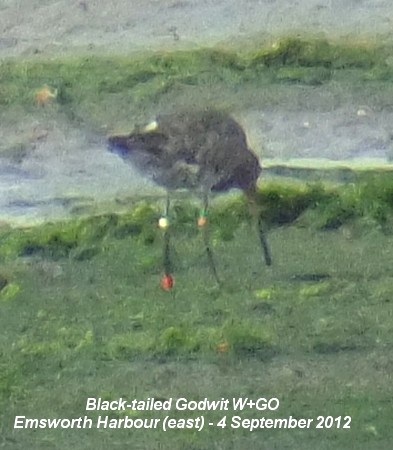
G+WR - Ringed at
Farlington on 10 Sept 2008 as adult male. It has been
regular wintering bird in Emsworth Harbour since that
time. We have had 76 sightings of it in Emsworth. Last
winter it was here continuously from 08-Aug-11 to
11-Feb-12.
Greenshank
There were about 8
Greenshank scattered around the channels in the
harbour. I saw one colour-ringed bird, but I could not
be 100% sure about the colours. I am fairly sure the
left leg was RO. The right leg could be LY, YY or WY.
Possible RO+LY.
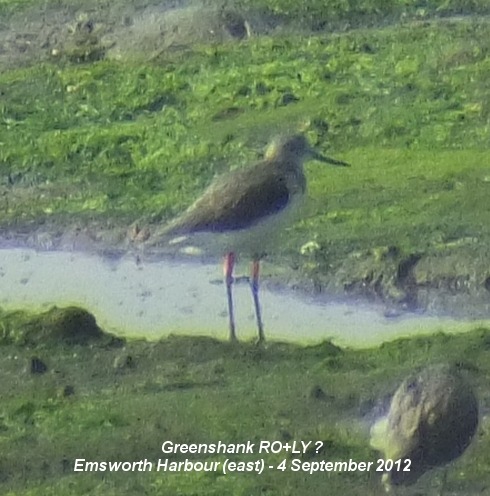
Other
harbour birds
Redshank (20),
Turnstone (4), Curlew (3), Little Egret (1),
Black-headed Gull (260), Herring Gull (4), Great
Black-backed Gull (2 adults).
Other
observations
A Dunnock was
constantly calling from Tamarisk bush on the marina
seawall path.
Hedgerow Crane's-bill
is still in flower along this path.
BROOK
MEADOW
Clouded
Yellow
A stroll through the
meadow this afternoon produced the first Clouded
Yellow of the year on the Lumley area. That was the
first Clouded Yellow sighting on Brook Meadow since
2003. I chased it around taking snaps, but none of
them came out. It just would not settle.
HARVESTMEN
Ralph Hollins provides
some extra information on Harvestmen that I was not
aware of when I wrote the short piece yesterday.
Thanks Ralph.
1. Many of the species
have their eyes mounted in an 'armoured turret' on top
of their bodies.
These special eyes can
in fact be seen on my photo.
2. They have no silk
glands and do not spin webs which makes one wonder how
they catch their prey. Harvestmen are omnivorous. They
will catch and eat smaller invertebrates and feed on
the remains of any dead animals they find.
3. They also have a
different sex life. Many of the species are
parthenogenic and reproduce without males but in other
species the males do have a penis and copulate (unlike
spiders in which the males extrude sperm but do not
have a penis - they use the palps that can be found
hanging from 'arms' in front of their faces to
'manually' transfer the sperm to the epigyne of the
female).
MONDAY
SEPTEMBER 3 - 2012
BROOK
MEADOW
'Daddy-long-legs'
As I was up dating the
signcases on Brook Meadow this afternoon, I noticed a
'Daddy-long-legs' resting on a leaf. But which
'Daddy-long-legs' was it? It had no wings, so that
must rule out a Cranefly (Tipula) which does
have wings. As it had a single rounded body, it could
not be a spider which has a clearly distinguishable
head/thorax and abdomen. So that left
Harvestman. Although they belong to the class
Arachnida, Harvestmen are in the order Opiliones and
are not spiders, which are members of the order
Araneae.
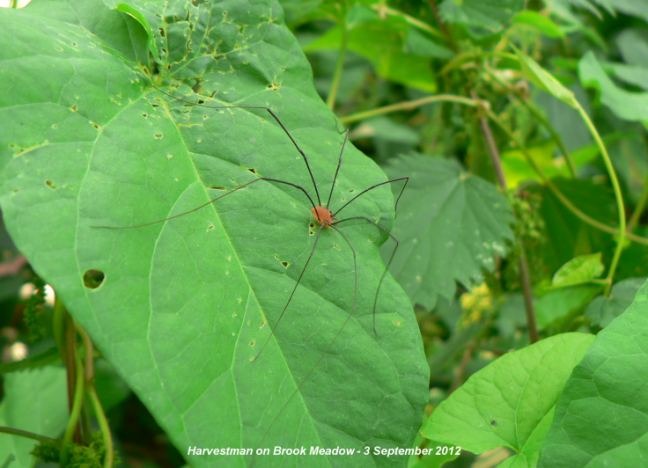
This Harvestman
appeared to have lost one of its eight legs, though
that is not uncommon. One interesting feature of this
insect was the bright orange colour of its body and
the absence of any marking. However, there are images
of Harvestmen on the internet that look very similar
to this one.
We have 23 species of
Harvestman living in Britain, though an amazing 6,500
species have been discovered worldwide. Harvestmen are
a very old family. Well-preserved fossils have been
found in the 400-million-year-old Rhynie cherts of
Scotland, which look surprisingly modern, indicating
that their basic structure has not changed much since
then.
SUNDAY
SEPTEMBER 2 - 2012
BROOK
MEADOW
Light drizzle did not
deter about 10 volunteers from turning up for the
regular conservation work session on Brook Meadow. The
main task was cutting and clearing the mass of
vegetative growth in the southern part of the north
meadow, using the power scythe for cutting and rakes
and bags for clearing the arisings. The area in and
around the small Osier plantation was also cleared.
This should be an attractive area, as Osier catkins
are always the first to show in the early
spring.

I saw what looked like
a family of Whitethroats feeding on the seedheads in
the north meadow. Robin was singing its autumn song.
Volunteers brought to my attention a Frog which was
revealed during the clearance.

SATURDAY
SEPTEMBER 1 - 2012
EMSWORTH
Great
Black-backed Gulls
At least three members
of the Great Black-backed Gull family that nested on
Slipper Millpond this spring and summer are still in
the area. An adult (probably female) was on the south
raft on Slipper Millpond this morning. Then in the
afternoon two juveniles were on Emsworth Millpond and
a little later they were both in the main harbour
along with an adult.

Mallard
ducklings
Mum and 8 ducklings
were on Emsworth Millpond this afternoon, a late brood
probably due to the difficult conditions earlier in
the season. A number of birds are probably having late
broods like this.
The
mystery climber - Clematis flammula
Martin Hampton
suspects the white-flowered plant I saw climbing on
the vegetation on the path alongside the golf course
at Sinah might Clematis flammula which is scented and
has flowers very like those in the picture. It is also
known as fragrant virgin's bower. I think he is
absolutely correct. Thanks, Martin.
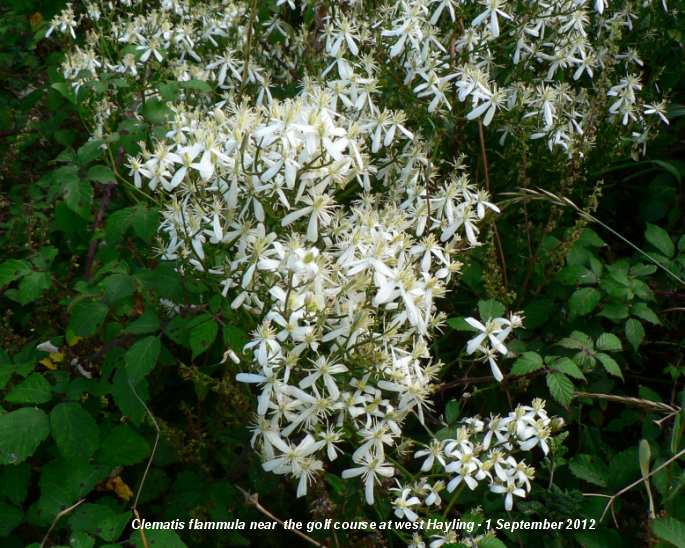
Wikipedia adds: It is
native to southern Europe and northern Africa, but it
is cultivated worldwide as an ornamental plant in
gardens. The woody vine bears fragrant white flowers
and small green achenes. When the flowers are newly
opened they have a strong sweet almond fragrance. The
vine grows in a tangled mass that is heavily sprinkled
with flowers throughout the warmer months. It is
popular with gardeners as a decoration along fences
and trellises, or as ground cover. If the vine has no
other plants or structures to climb on, it will climb
on itself, forming a large, densely tangled bush. The
plant sends out many shoots and can reach over five
meters in height. It is sweet-smelling but poisonous.
In some areas, this species has become a nuisance
after its introduction. It is a weed outside of
gardens and landscaped areas. Clematis flammula var.
maritima is a hardier variety that is adapted to sand
dunes. It is currently being studied as an agent of
soil stabilization on eroded sandy beaches.
Tony's
dragonfly - Migrant Hawker
Regarding the
dragonfly that Tony Wootton took in flight on West
Thorney yesterday, Ralph Hollins agrees it looks like
a Common Hawker but points out that that species does
not normally occur in our area (though it is common in
the New Forest and as near as Thursley in Surrey).
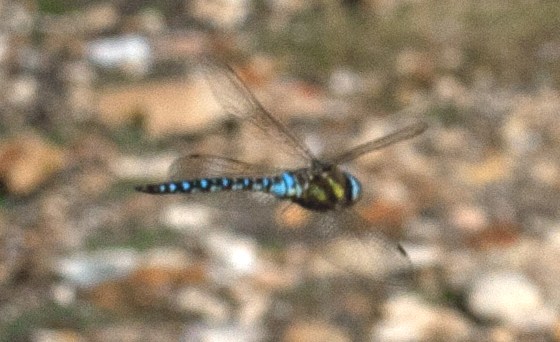
He says, another
possibility, which would be found here, is Migrant
Hawker. When flying a reliable feature to look for is
the bright blue spot on the side of the base of the
abdomen, as no other Hawkers show this and Tony's pic
does show this. However, the photo does give the
impression of the bulkier Common Hawker but Ralph
still thinks Migrant Hawker is a possibility. Ralph
provides a photo that Heather Mills took of a Migrant
Hawker during a visit to Browndown (Gosport) today
showing the same prominent blue spot as in Tony's
photo which is further evidence that that may have
been what Tony saw.
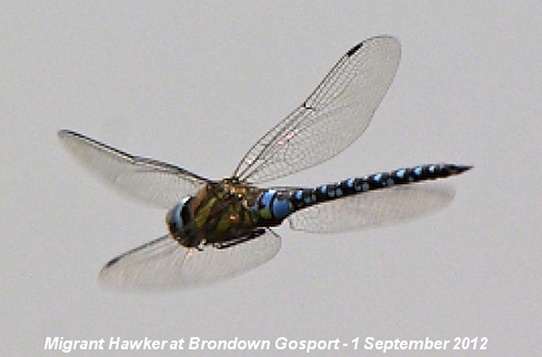
Hayling
Island
Having seen my photos
from Hayling Island yesterday, Malcolm Phillips had a
walk around Hayling west beach for the first time
ever. What a nice experience to have. Malcolm got some
good photos, including this one of the local Kestrel
taking off from the golf club fence.

For
earlier observations go to . . . August
1-31